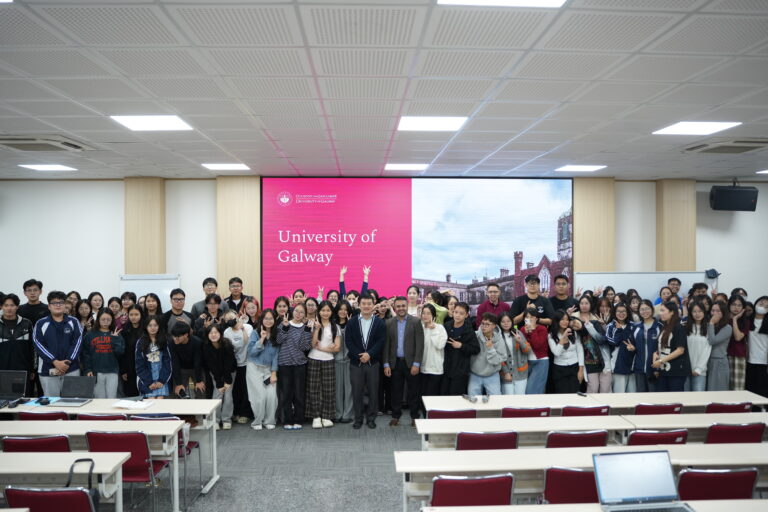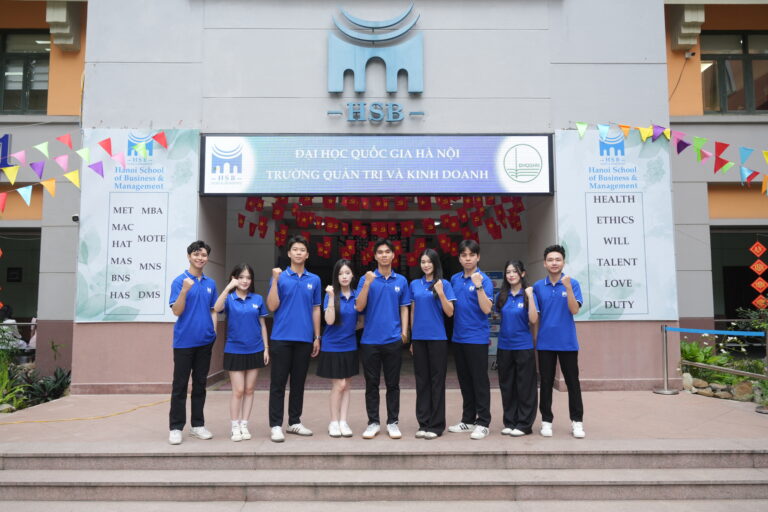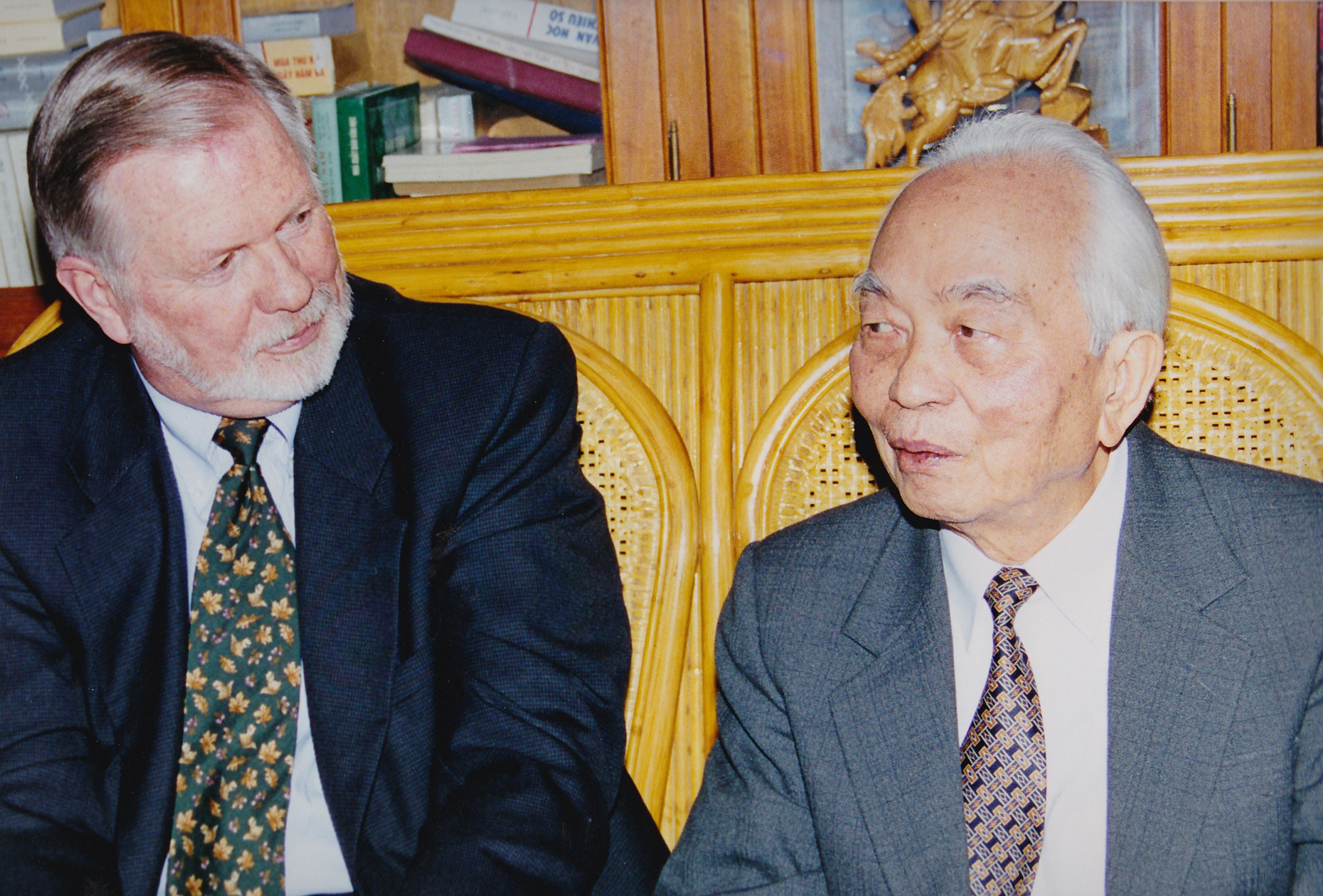 The more than a decade that I spent working with and learning from the leaders and professors of HSB
The more than a decade that I spent working with and learning from the leaders and professors of HSB
and the students enrolled in the joint HSB-Tuck programs that I had the privilege to direct were of great significance to me and my colleagues at Tuck.
By: Joseph A. Massey. October 1, 2016.
Professor Emeritus of International Business
Founding Director Emeritus, Center for International Business
Tuck School of Business at Dartmouth
* Hanoi School of Business (HSB) in both English and Vietnamese language is a member school in the model of VNU Hanoi. Thanks to the great supports and help of all distinguished US friends, business community, lecturers, and alumni, HSB has become the unique model of school in Vietnam that develops sustainably on 4 pillars: Public, Autonomy, Not-for-profit, Public Private Partnership. In 2016, HSB changed its name to Hanoi School of Business and Management with the logo and HSB brand name remained. Today HSB operates new and interdisciplinary programs from bachelor (MET) to master (MNS, MBA) and PhD (DMS). More information at www.hsb.edu.vn
It is a profound honor and a pleasure to have been invited by the Hanoi School of Business and Management (HSB) at the Vietnam National University, Hanoi (VNU) to contribute to this history of HSB, the first market economics business school in Vietnam. I had the great good fortune to be a partner with HSB for more than a decade, from the very early days in 1994 when the school, which today is among Vietnam’s leading educational institutions, existed only in the ideas and hopes of a visionary group of Vietnamese business leaders and scholars, until 2006, the year before my retirement from teaching at the Tuck School of Business at Dartmouth and in which I last took part in one of Tuck’s joint programs with HSB.
Learning about Plans for a Market Economics Business School in Vietnam
In late 1993 I received a telephone call from a former colleague at the White House Office of the U.S. Trade Representative (USTR). The caller was Michael Samuels who had been the U.S. Ambassador to the GATT, the General Agreement on Tariffs and Trade, now known as the World Trade Organization (WTO). Ambassador Samuels was calling, he said, to convey to me the invitation of the Vietnamese Government and the Vietnam Chamber of Commerce and Industry (VCCI) to be a speaker, along with himself and an official of the Ministry of Commerce of Thailand, at a seminar on trade in Hanoi early in the coming year. I was at the time a Professor and Director of the Center for International Business at the Tuck School of Business at Dartmouth College in the United States.
The reason I had been extended the invitation is that prior to joining the Tuck School faculty I had served from 1982 to 1992 in several White House posts at both the Office of the U. S. Trade Representative (USTR) and the Office of Policy Development, culminating as the chief United States trade negotiator with China and Japan from 1985 to 1992. My experience in negotiating with China was especially relevant for the purposes of the seminar since Vietnam was, the sponsors knew, soon to be resuming diplomatic relations with the United States. That would mean that our two countries would shortly thereafter be negotiating a bilateral trade agreement and that Vietnam would seek admission to the GATT/WTO. The U.S., it was thought, was likely to make similar demands on Vietnam as a nation in the early stage of transition from a planned to a market economy as we had made in my negotiations with China. I was delighted at the invitation and very pleased to take part. I had never been to Vietnam and saw the seminar as a way in which my USTR experience might be of use in promoting US-Vietnam relations.
The seminar took place in Ho Chi Minh Exhibition Hall in Hanoi in January 1994. At the morning coffee break on the second day of the seminar, I was approached by a young man, Mr. Nguyen Thu Do, who said he was an official in the Office of the Prime Minister working on economic affairs. Mr. Do explained that he had received a Master’s degree from Harvard and after returning to Vietnam was part of a group of young Vietnamese who were interested in having a modern market economics business school like the Tuck School established at the Vietnam National University, Hanoi. He asked if the Tuck School would be willing to help. I responded that I personally would be very pleased and honored to help and that I was sure the Tuck School would too. I promised to take up the matter with Tuck’s dean upon my return to the US. Helping the Founders group and the Vietnam National University in Hanoi to create a modern market economics business school would be a way in which I, and my fellow professors at Tuck, could make a meaningful contribution to Vietnam and help, in a very small way, promote the healing of the relationship between our two countries, something that was—and is— very important to me and to many Americans.
Meeting the HSB Founders Group
Later during that visit, Mr. Do introduced me to the group of his friends who shared with him the aim of creating a new business school that would teach the disciplines that Vietnamese executives and managers would need as the country proceeded to open the economy to market forces and foreign competition in line with the policy of Doi Moi. I think of that group as the Hanoi School of Business founders group. They included two of the first Vietnamese to attend graduate business school in the United States post-1975, Mr. Tran Vu Hoai and Ms. Dinh Thi Hoa, who had both received MBA’s from the Harvard Business School. Also part of the group was Mr. Ha Trung, a Vietnamese-American businessman who had come to know Mr. Hoai and Ms. Hoa while they were students in Boston.
A key and central member of the group was someone who had not studied in the U.S., and who had not studied business, Dr. Truong Gia Binh. Dr. Binh had studied and received a doctorate in mathematics and physics at Lomosomov University in Moscow. Dr. Binh was the driving force who over the next decade would propel HSB from a visionary conception to a highly functioning institution. When he had returned from Moscow to Hanoi he had been appointed head of The Food Processing and Trading Company (FPT). When I met him in 1994 he was dramatically transforming that company into a technology company that would become one of Vietnam’s leading and most international companies, The Corporation for Financing and Promoting Technology, the new FPT.
After the conclusion of the January 1994 international trade seminar and having spent a number of sessions discussing plans for the new school with the founders’ group, I returned to the Tuck School and met with Dean Paul Danos to inform him of this opportunity to make a contribution to business education in Vietnam. He was supportive but said that he expected me to lead the effort for Tuck and to take on the responsibility for raising whatever funding would be needed.
The first thing to do was to rally interest and support among the Tuck faculty. Tuck Professors Paul Argenti and Mary Munter were going to Thailand during the March 1994 spring vacation so I persuaded them to add a visit to Hanoi to their trip and meet with the founders’ group. They were impressed with the high quality of the founders’ group and of their vision for HSB and came back equally enthusiastic as I. Meanwhile, Dr. Binh and the founders’ group had recruited the first young faculty members who would teach at HSB. A Tuck School team, including Prof. Argenti, Prof. Wayne Broehl and I worked with the HSB founders on development strategy and on the early programs and curriculum. The initial strategy was to focus first on executive training programs before turning to the establishment of an MBA program, with decisions on other programs, including possible undergraduate and/or doctoral programs, to be left for the future. One matter that came up very early in our discussions, and caused some humorous back and forth, was what the name of the school should be: whether it should be called the Hanoi Business School or the Hanoi School of Business. The group decided on the latter so that its abbreviation, HSB, would not be confused with that of another business school with the initials HBS.

It was my honor to meet General Vo Nguyen Giap at his home
Establishing HSB as new business school involved several challenges. One important one related to how it would be accepted and regarded by the administration and the other relevant faculties of the university. At the very outset of HSB’s existence, Professor Tran Ngoc Hien, a leading economist and the head of the VNU economics department, was named Dean of HSB. The view of my Tuck colleagues and myself at the time was that coming as he did from having been the head of VNU’s political economics department, Dean Hien could help the new business school gain administrative acceptance from the university’s existing economics and related faculties, cement its links to the university administration, and establish its goals and plans as consonant with national needs and policies in the view of the education authorities. When Dean Hien stepped down after a short tenure, Truong Gia Binh assumed the position of Dean of HSB and led it for the entire remaining time in which I was involved, and until Prof. Hoang Dinh Phi continued to be the third Dean of HSB in 2013. Early on, I also met and became friends with the late Prof. Nguyen Van Dao, the President of Vietnam National University, Hanoi at the time. Prof. Nguyen Van Dao strongly supported the founders’ group in establishing an autonomous status for the school as a separate and distinct unit at VNU with its own financing, personnel, and academic curriculum. The establishment of HSB as an autonomous business school within VNU was a first for the country’s national university system and set the model for others to follow. It was my sad duty several years later to represent the Tuck School at the national memorial service for President Van Dao after his untimely and tragic death in a traffic accident. His early advocacy and strong support both within the university itself and with the government education authorities were of vital importance to HSB.
A second challenge was how HSB would be regarded by Vietnam’s business community. Here, the collective reputation of the members of the founders’ group proved to be invaluable. The key members had extensive relationships among both Vietnamese and foreign firms operating in Vietnam. Their expertise and success in building and running businesses was well-known and respected and their commitment to HSB provided a valuable asset for the new school, an asset that was amplified by the appointment of Truong Gia Binh as Associate Dean and then as Dean.
An obvious challenge was one shared by all startups: funding (financial resource). Vietnam National University itself provided an important boost by making a parcel of land on the VNU Hanoi campus available to HSB for its facilities. But HSB would have to raise the money to erect a building on the land to house the school. HSB’s leadership turned to the Vietnamese business community to raise the money needed and the business community responded handsomely, with numerous companies and business leaders contributing all the funding that was needed to build HSB’s beautiful modern building within a year or two of the school’s founding. From this foundation, HSB grew into a position of national recognition and prominence.
Funding of operations was another need and here HSB adopted a very successful strategy. Instead of immediately establishing an undergraduate BBA or graduate MBA program and depending on tuition, HSB chose to start by offering short executive training courses in specific topics of immediate practical concern to Vietnamese managers. For HSB this had the advantages that the participating companies could afford to pay significant fees for the courses and that managers satisfied with one of the courses recommended HSB to their colleagues and thus provided a constituency for expanded course offerings. In short, HSB was operating the way a start up business should operate, minimizing costs, providing the market with a product in demand, and in the process generating and increasing cash flow. Within a few years the cash flow from the short courses made it possible for the school to put in place an MBA program with both full and part time options. Importantly, these short courses also proved very helpful for the school in another of its challenges: recruiting, training and retaining faculty. Young Vietnamese with an MBA were in short supply and in demand by companies that could offer attractive salaries and benefits. Thanks in part to the income from these short courses, HSB was able to offer compensation adequate to attract young faculty and provide them with teaching experience and their own networks of contacts within the business community.
The International Executive Development Program for Vietnamese Managers
The first major program of the new school, one that played a key role in getting it successfully launched and recognized by the Vietnamese and international business community, was the joint HSB-Tuck International Executive Development Program for Vietnamese Managers (IEDP). As the Tuck School co-director of IEDP, I had overall responsibility for the program; Professor Paul Argenti served as academic director. On the HSB side, Dean Binh served as IEDP co-director.
IEDP focused on providing training in international standard business disciplines for managers who were running or held positions of responsibility in Vietnamese companies, both state-owned and private. I set out to raise the money for that program and was pleased at the strong positive response. A number of U.S. companies contributed funds for the effort. Citibank was among them and its country head, Bradley LaLonde, also personally became an active and enthusiastic supporter of the new business school. Mr. LaLonde, now the CEO of Vietnam Partners, remains an active supporter of business education in Vietnam and of HSB.
By far the greatest source of financial support for the IEDP program was the Freeman Foundation of Stowe, Vermont, the family foundation established by Houghton Freeman, the retired Chief Operating Officer of AIG, Inc. and his wife Doreen Freeman. Over the eight years in which the program was held, the Freemans’ support, totaling several millions of dollars, covered all of the costs of the annual three-part, six month long program of courses and experiential learning that comprised IEDP. The generous support provided by the Freemans was crucial to the IEDP program, a program that was the cornerstone of HSB in the first decade of its existence. I know that all of us involved with IEDP, both at Tuck and HSB, share a deep appreciation of the Freeman Foundation’s support for IEDP and for a number of the joint Tuck-HSB consulting projects about which I will write below.
The first part of the IEDP program began with a week of classes each January introducing market economic business basics taught by a Tuck professor, almost always the late Professor Wayne Broehl, assisted by HSB faculty members. Thereafter for the next two months weekly classes taught by the HSB faculty would continue, going deeper into the topics that had been introduced. Then, in March during the U.S. Spring Break period, a team of Tuck professors would come to Hanoi and teach intensive classes covering the range of business disciplines from accounting and finance to operations, supply chain management, marketing, human resource management, international trade, strategy and various other topics depending on faculty specialties and expertise.
Over the lifetime of IEDP more than half the Tuck School faculty taught in the program, many of them in multiple years. They included both Dean Danos and Tuck’s previous Dean, Professor Colin Blaydon. At HSB, a number of the founders group, including Dean Binh, Tran Vu Hoai and Ha Trung, taught in the first two years in IEDP while the school undertook the task of recruiting faculty. As the faculty took shape, many lecturers came to play central roles, including Dr. Tran Phuong Lan and Ms. Ha Nguyen, both of whom were directly involved in IEDP and in the management of one or another of the school’s key programs. Other HSB professors or lecturers including Roger Ford, Augustine N. Vinh, Nguyen Thi Mai Linh, Do Xuan Truong, Nguyen The Hung, Nguyen Viet Anh, and others taught in either some of the IEDP sessions or in one or more of HSB’s short courses. Ha and Lan taught in those short courses as well, of course. Mr. Phan Thanh Tung and Ms. Nguyen Thi Mai Linh provided management support for these corporate training programs. The important role of organizing IEDP, coordinating teaching schedules, faculty and participants’ travel and other administrative matters was carried out with great effectiveness and an infectious enthusiasm by Ms. Hong Thanh Thoai Nhi who was ably assisted by Ms.Le Mai Chi. Ms. Darlene Bailey assisted with IEDP administrative matters at Tuck.
A central focus of IEDP was to instill in the students a firm grasp and appreciation of the entrepreneurial approach and spirit that is so central a market economy, where new companies are constantly being created and undertake the leap, always risky and sometimes rewarding, of bringing new ideas into reality as start up businesses, in a process that enriches and expands the choices available to consumers, refreshes and invigorates the flow of competition, and keep societies economically vital. The students in IEDP were already experienced business managers, but their experience had been acquired in existing enterprises created, for the most part, in a planned economy. With doi moi the Vietnamese economy was moving in a new direction, one in which businesses would need to develop and implement plans that were crafted and based on the opportunities and risks arising from market forces and competitive factors. So the third part of the IEDP program was a continuing focus, from start to finish, on entrepreneurship, the process of creating a new business.
In January, the managers enrolled in the program were required to form into groups of five to six persons who would work together over the course of the program to develop business plans for new ventures. In March, Professor Argenti and I would review and critique each group’s business plans. And, in the third stage of the six-month long program, several of the groups, often comprising more than half the participating students, would travel on a two-week long trip to the U.S.to take part in a study tour that I arranged and led each summer, the finale of which was the presentation at the Tuck School by the IEDP groups of their business plans to the Tuck faculty and invited US business executives, private equity and venture capitalists, investment bankers, and others. On a number of occasions, Houghton Freeman drove down to Hanover from the Foundation’s headquarters, a small white farmhouse in Stowe, Vermont, to join the panel at Tuck that critiqued the IDP teams presentations.
Prior to the final week of classes and business plan presentations at Tuck in Hanover, New Hampshire, Tuck’s Center for International Business arranged for the HSB groups to visit numerous businesses on both the West and East coasts of the U.S. In the first several years, the West Coast meetings took place in Seattle, where we visited facilities and received briefings at Microsoft and Boeing. In the latter years of the program, we visited Silicon Valley where the groups made preliminary presentations of their business plans to venture capitalists and Napa Valley where they were briefed at the largest independent vineyard in the valley, owned by Andy Beckstoffer, a Tuck School alumnus, on the business economics of high value added agriculture, and, thanks to Mr. Beckstoffer’s introduction, were also invited to visit and sample the renowned cabernet sauvignon wines at Stags Leap Cellars winery.
On the East Coast, in Washington, D.C. we were briefed by officials of USTR, the State, Commerce and Treasury departments, and the Vietnamese Embassy, on U.S. government policies relevant to U.S.-Vietnam trade, economic and business relations, and by the U.S. Chamber of Commerce and the US-Vietnam Trade Council on business-government relations in the American system. In New York City, we met and were briefed by major Wall Street firms including AIG, Citibank, Morgan Stanley and others, and at the Federal Reserve Bank where officials briefed the groups on the functioning and significance of its role in U.S. monetary policy before guiding us down to the vault, deep underground, where group members were able to view (but unlike the wine, not to sample) the gold bars worth billions of dollars that the Bank holds as steward for many foreign countries.
The IEDP groups visiting the United States traveled from one meeting or event to another by buses that Tuck’s Center for International Business had chartered. It was my job, as program director, to arrange the meetings, and my good fortune, therefore, to accompany the groups on the bus so that I got to know and become friends with the group members, many of whom I still meet whenever I come to Vietnam. To make the bus travel more enjoyable, it was my practice to start each day’s bus ride by standing in the aisle at the front of the bus and singing a song, usually what Americans call a “golden oldie,” some well known tune that would put one in a good mood. After I finished, amidst the smiles and laughter of the group, I would call on IEDP members at random, saying “ok, your turn to give us a song.” Invariably, the group members would respond with one person after another singing songs from home in which the whole group would always join in chorus.

IEDP Class of 2003 at Tuck Graduation.
Our bus rides took us not only to meetings but also to see some of the memorable sights of America. We saw the fog roll across the Golden Gate Bridge in San Francisco, the bustling Pike Place Market on Seattle’s Elliott Bay waterfront, the vast carpets of wild flowers adorning the slopes of Mt. Rainier, the acres and acres of flowers in the computer-controlled greenhouses of Nurserymen’s Exchange in Half Moon Bay, California, the magnificent gothic campus of Yale University in Connecticut and, on the last leg of the bus ride from New York to Hanover, the green hills and valleys of Vermont. In New York, for the first five years of the program we stayed at the Mariott World Trade Center Hotel until it, and the neighboring Twin Towers whose observation deck many IEDF members visited, were destroyed in the tragic attack of September 11, 2001.
Nearly 350 executives of Vietnamese companies, from all across the country and with both Hanoi and Ho Chi Minh City strongly represented, participated in the IEDP program during its eight year run from the first student class in 1996 to the last in 2003. The executives in the program came many of the country’s largest and most famous state-owned companies such as PetroVietnam, VINACOAL, VINASTEEL, Vietnam National Cement Company, VNPT, FPT, BIDV, EXIM Bank, VietcomBank, Bao Viet, Bao Minh, Vietnam Airlines, Vietnam Railways, and Hanoi Beverage Company.
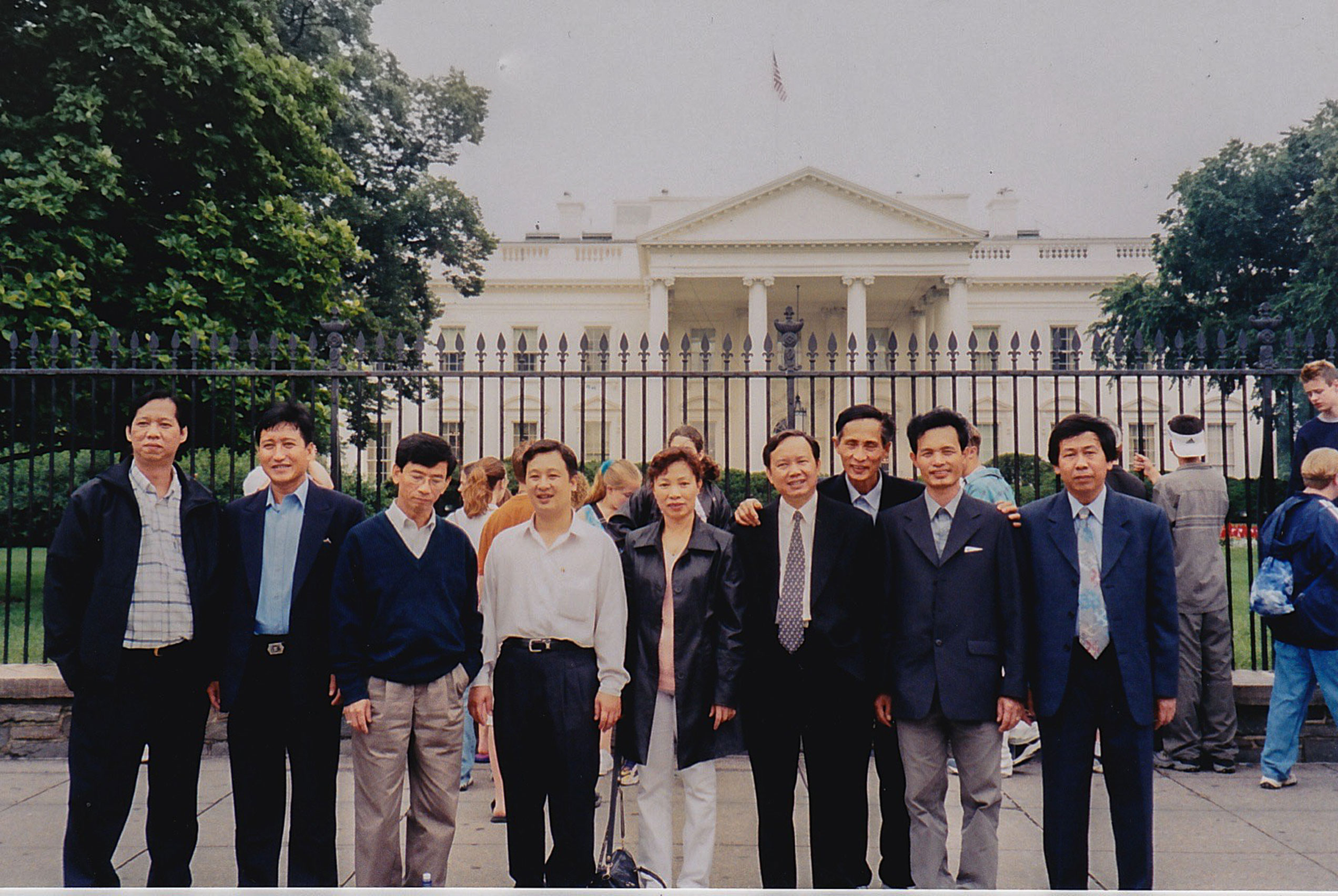
IEDP Class 2001 at White House.
In addition, reflecting the era of Doi Moi, executives in the program also came increasingly from private sector companies across a wide range of sectors. Some were already well-known leaders in their fields, including such companies as AA Corporation in furniture and interior decoration, Galaxy Co. in marketing, public relations and consulting, Kinh Do in bakery and fast moving food products, and Thien Long Co. in stationery products. Others would soon go on to build such leading companies as NovaLand in real estate and agricultural products, and DatVietVAC in media, entertainment and communications, among the numerous successful companies built by IEDP graduates. It was estimated that by the end of the program the companies whose executives had participated in IEDP accounted for over 30% of Vietnam’s GDP and that IEDP graduates comprised 80% of Vietnam’s chapter of the Young Presidents’ Organization (YPO).
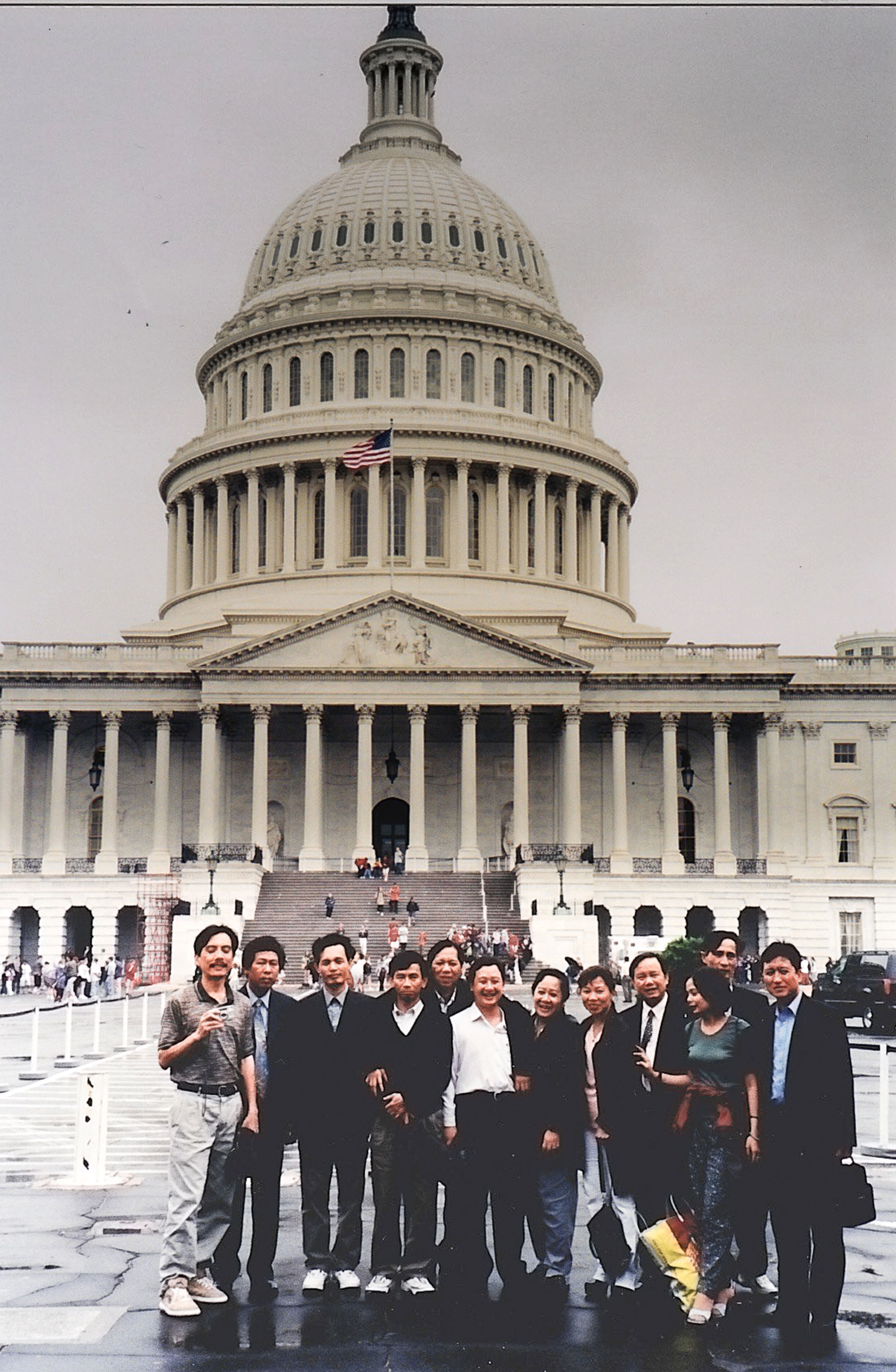
IEDP Class 2001 at US Capitol
The list of the many companies whose executives and managers studied in the IEDP program is too long for me to be able to mention all here. To those IEDP graduates whose companies I have not mentioned, my apologies, and please know that it is only space limitations that have kept me from doing so. I am proud of all our graduates and the contributions you have made to the remarkable growth of the Vietnamese economy over the past two decades.
The Joint HSB-Tuck Consulting Projects
A second joint HSB-Tuck joint program was associated with a program of international consulting projects for Tuck MBA students that I co-founded and co-directed starting in 1996. During the period from 1996 to 2006 this Tuck program carried out some 115 projects for more than 50 clients in 30 countries around the world. With Dean Binh’s agreement I made working with HSB on projects in Vietnam a key part of this program and a number of the very first projects in the program were conducted in Vietnam.
The consulting projects typically involved a team of five or six Tuck student doing an analysis of an issue that a client company was dealing with in a country outside the United States. The students, under the guidance of a Tuck School professor—in Vietnam, for all projects but one, myself—, would work on the issue over the Fall term at Tuck, then travel with the professor to the foreign country and spend three weeks doing research onsite. In Vietnam this phase of the consulting project brought HSB students and faculty onboard, with HSB faculty advising, and HSB students accompanying their Tuck counterparts in all aspects of the in-country work—visits to interview clients, customers or suppliers and government offices and preparing a preliminary report for the client.
The Tuck students, whose average age was 29 or 30, had already had a number of years of work experience and were thus able to share their interviewing, research and analytic skills with their younger HSB counterparts. The HSB students and their HSB faculty adviser, in turn, could provide to the Tuck students a deeper understanding of Vietnamese culture, the Vietnamese market and Vietnamese business practices. Some of these joint projects were done for foreign companies including Cargill, the Walt Disney Company, Johnson and Johnson, and Nike, among others. A number were done for Vietnamese companies including the Bank for Investment and Development of Vietnam (BIDV), Fahasa, FPT Soft, Hanoi Beverage Company, Kinh Do, Techcombank and Vinausteel. The Freeman Foundation once again as with IEDP, generously provided funding support for the projects for the Vietnamese clients.

Tuck-HSB BIDV Consulting Team 2004 #1
A Final Note
The more than a decade that I spent working with and learning from the leaders and professors of HSB and the students enrolled in the joint HSB-Tuck programs that I had the privilege to direct were of great significance to me and my colleagues at Tuck. They provided us with an invaluable opportunity to witness, learn new and important lessons from, and play a supporting role in the development of business education in Vietnam during the country’s historic and still ongoing movement toward a market economy. They blessed me with enduring friendships with remarkable people whom I greatly admire. The experience has been for me a life-changing, life-enriching journey that has left me with a deep affection for Vietnam and for HSB. Let me conclude by sending to all members of HSB family, and to all of my former students, my warmest best wishes for ever greater success.
